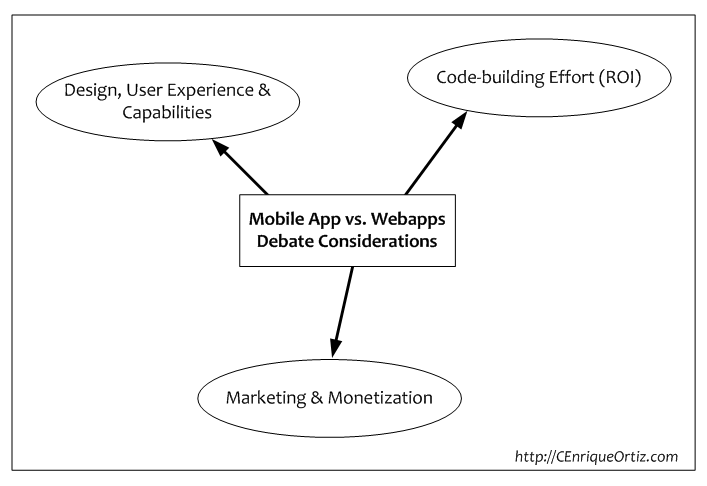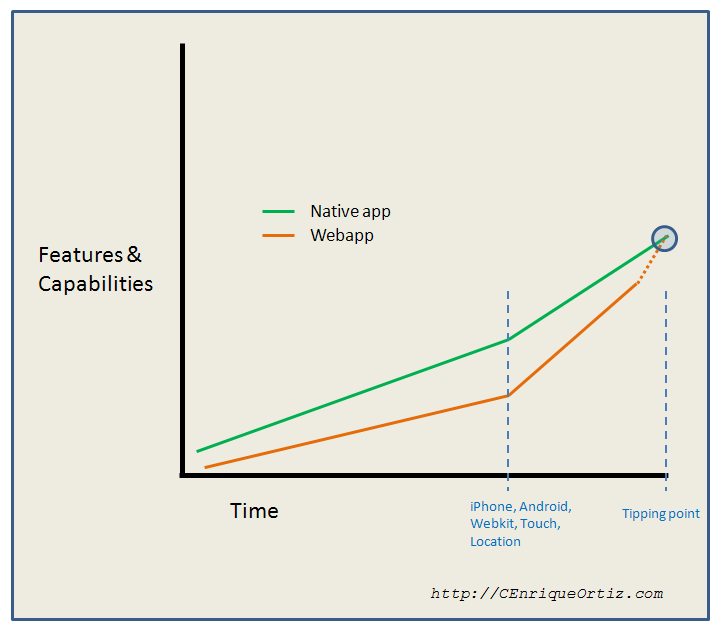(This is part of a series of blog posts on Mobility in 2011)
The debate of mobile (native) app vs. webapp is not new. This is a decade-old topic that has been debated since the days of WML.
Today the debate is pretty much the same debate.
The debate’s topics and considerations typically center around “design, experience & capabilities”, “marketing & monetization”, and “code-building-effort”.

…where:
- The “design, experience & capabilities” part of the debate is about the application design, features & technical capabilities and its effect on the user experience; today this favors native apps;
- the “marketing & monetization” is about awareness, visibility and discoverability, for example, creating a popular app will give you lots of visibility and direct and indirect monetization methods, and today it currently favors apps thanks to the app markets and stores, and;
- the “code-building-effort” part of the debate is about ROI. This is mostly debated by those responsible for creating and delivering great applications and solutions as efficient as possible: fast development cycles with minimal resources, minimizing code duplication & maximizing code re-usability, better and cheaper ways for distribution and deployment. Topics like fragmentation, browser capabilities and centralized distribution come to light. This part of the debate favors webapps, unless you focus on a single native app platform such as the iPhone. Android is fragmented but this should improve over time as the platform matures (in theory). The webapps centralized model is a winner, but so is the centralized model of app stores. At the end, due to the previous two debate points, native apps are leading the way with iPhone and Android as the platforms of choice. But this is changing as well, thanks to toolkits such as jQuery Mobile which helps bring consistent webapp development and user experience across browsers. While apps are a clear winner today, an increasing number of customers are asking for mobile web versions of their apps before they commit to native apps; these typically are customers who want to go mobile now and who understand the ROI benefits of webapps across mobile platforms, yet are doing this as a starting point before introducing the app version of their applications (since they too understand the user and business benefits of native apps). It is important to note that hybrid app approaches that brings together the benefits of webapps into native apps (containers) is something to consider in the meantime.
Two Important Tipping Points
Below I cover two thoughts on the matter of app vs. webapp, and two tipping-points that most occur before the debate of apps vs. webapps become a moot point .
While the browser of today is a number of magnitude more advanced than its predecessors from the days of WML (and CHTML, etc), the relationship between apps and webapps have persisted over time; that is, from the application perspective the native app has always been ahead when it comes to features, user experience & capabilities. This answers the “design, experience & capabilities” part of the debate and the top reason why still today mobile apps are more popular than webapps.
But it is just a matter of time before webapps will be very close or equal to apps. If you were to picture this in a chart, based on experience, it would look something like the following:

…where: while the native platform and apps have had more features & capabilities than the webapp, as the browser becomes more capable (including performance) and the markup language becomes more “expressive”, the two lines will meet (but will they cross?); this is the first tipping point. And recall that “…after the tipping point has been passed, a transition to a new state occurs.”
In the chart above I also attempt to capture the impact the iPhone, Android and the Webkit, as well as sensors such as touch & location all have had in the progression of apps and webapps, and how they have contributed to awesomeness for both app and webapps.
But there is a second tipping point to be crossed. The second tipping point is related to user experience & perception. If we were to visualize this as well, it would look similar to the chart above, but with additional/different triggers. Apps have been very successful in creating analogous experiences to the physical world and its attributes, in ways webapps haven’t being able to achieve yet. Apps you can find, buy and own, see, listen to and touch in ways webapps don’t offer at this point. The way apps are owned is unique too. And people even socialize about apps in ways we don’t see yet about webapps. Before this tipping is crossed though, tipping point #1 explained above must be crossed first.
Will these tipping points occur in 2011? I don’t believe so. In the meantime, this has major implications on marketing and monetization which favors native apps.
So the debate of mobile webapps vs. native apps is not new. The debate of app and webapps is really relative as dictated by specific needs. We can debate the technical merits for each, the business merits or both. Today, the the user experience and perception favors apps which translates to business benefits ($) and thus outweigh the benefits of webapps. But there are business reasons why go webapp such as going mobile faster across platforms. The app is still ahead of webapps when it comes to the combination of design, experience & capabilities + marketing & monetization + development ROI, but the gap continuous to close; it is a matter of time. From the capabilities perspective such as a graphical and transforms, performance, sensors, connectivity, storage and offline behavior, the mobile web browser is rapidly advancing, and when combined with better webapp discoverability, marketing and revenue models, then we will be closer to the “features & capabilities” and “experience & perception” tipping points at which time the distinction between mobile apps and webapps will become a moot point.
Related to this, see: Is 2011 the year of the Mobile Web apps? (Open Gardens)
Related posts from About Mobility:
- A Response to “Mobile Web 2.0: AJAX for mobile devices as the preferred platform for mobile app development” (2006)
- The Future of the Web and Mobile (2007)
- The Future of Web Applications is “Local” (2007)
- Is Local faster, fresher, better? Many say Yes… (2008)
- App Stores are the New Deck (2008)
- The iPhone and Android Platforms as Validators (2008)
- Mobile Apps in 2009: Local/Native, Mobile Web, App Stores (2009)
- Resolving Device Fragmentation Issues – Mobile Web and Local Apps (and Google) (2009)
- Looking back — Local faster, fresher, better… (2010)
- …for other search my blog
ceo
Pingback: Mobility in 2011 | About Mobility
Pingback: Native apps vs Web apps - Abiro